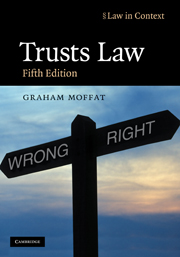Book contents
- Frontmatter
- Contents
- Preface to the fifth edition
- Acknowledgments
- Table of abbreviations
- Useful websites
- Table of statutes
- Table of statutory instruments
- Table of cases
- 1 Trusts introduced
- 2 The evolution of the private express trust
- 3 Taxation, wealth-holding and the private trust
- 4 Creating the trust – I
- 5 Creating the trust – II
- 6 Trusts and public policy
- 7 Flexibility in relation to beneficial entitlement
- 8 The taxation of private trusts
- 9 An introduction to trustees and trusteeship
- 10 Aspects of the management of trusts
- 11 Trusteeship, control and breach of trust
- 12 Implied trusts and the family home
- 13 Trusts in commerce I: occupational pension schemes
- 14 Trusts in commerce II: commerce and equitable remedies
- 15 Trusts in commerce III: commerce, credit and the trust
- 16 Trusts in commerce IV: fiduciary relationships, commerce and the trust
- 17 Trust, contract and unincorporated associations
- 18 An introduction to the law of charity
- 19 A legal definition of ‘charity’
- 20 The regulation of charities
- Index
18 - An introduction to the law of charity
- Frontmatter
- Contents
- Preface to the fifth edition
- Acknowledgments
- Table of abbreviations
- Useful websites
- Table of statutes
- Table of statutory instruments
- Table of cases
- 1 Trusts introduced
- 2 The evolution of the private express trust
- 3 Taxation, wealth-holding and the private trust
- 4 Creating the trust – I
- 5 Creating the trust – II
- 6 Trusts and public policy
- 7 Flexibility in relation to beneficial entitlement
- 8 The taxation of private trusts
- 9 An introduction to trustees and trusteeship
- 10 Aspects of the management of trusts
- 11 Trusteeship, control and breach of trust
- 12 Implied trusts and the family home
- 13 Trusts in commerce I: occupational pension schemes
- 14 Trusts in commerce II: commerce and equitable remedies
- 15 Trusts in commerce III: commerce, credit and the trust
- 16 Trusts in commerce IV: fiduciary relationships, commerce and the trust
- 17 Trust, contract and unincorporated associations
- 18 An introduction to the law of charity
- 19 A legal definition of ‘charity’
- 20 The regulation of charities
- Index
Summary
Introduction
Charity is a deep-rooted element in human behaviour. To provide emotional, spiritual or material comfort to those in need is an instinctive aspect of social behaviour, and is reinforced by religious and ethical precepts extolling it as one of the most ennobling forms of conduct (see generally Chesterman Charities, Trusts and Social Welfare (1979) ch 1). In the words of a standard legal text (Tudor on Charities (9th edn, 2003) p 1) elaborating on the words of Sir William Grant MR in Morice v Bishop of Durham (1805)): ‘in its widest sense, the word “charity” denotes “all the good affections that men ought to bear towards each other”.’ And at its best, charity invokes a warm response. There is a touching depth of pity and sympathy shown by the following message sent with a donation in 1966 to the Aberfan Disaster Trust Fund: ‘Please use this small amount in any way you wish. I was saving it up for a new coat, O God, I wish I had save [sic] more. Yours sincerely, A Mother’ (Nightingale Charities (1973) p 178). The Bob Geldof-inspired Band Aid Trust appeared to strike a similar chord when remarkably raising £69m in 1985 in aid of famine relief. And the fund-raising antics displayed on ‘Red Nose Day’ commonly raise in the region of £50m for Comic Relief to be used for a wide range of charitable purposes.
- Type
- Chapter
- Information
- Trusts LawText and Materials, pp. 913 - 963Publisher: Cambridge University PressPrint publication year: 2009



